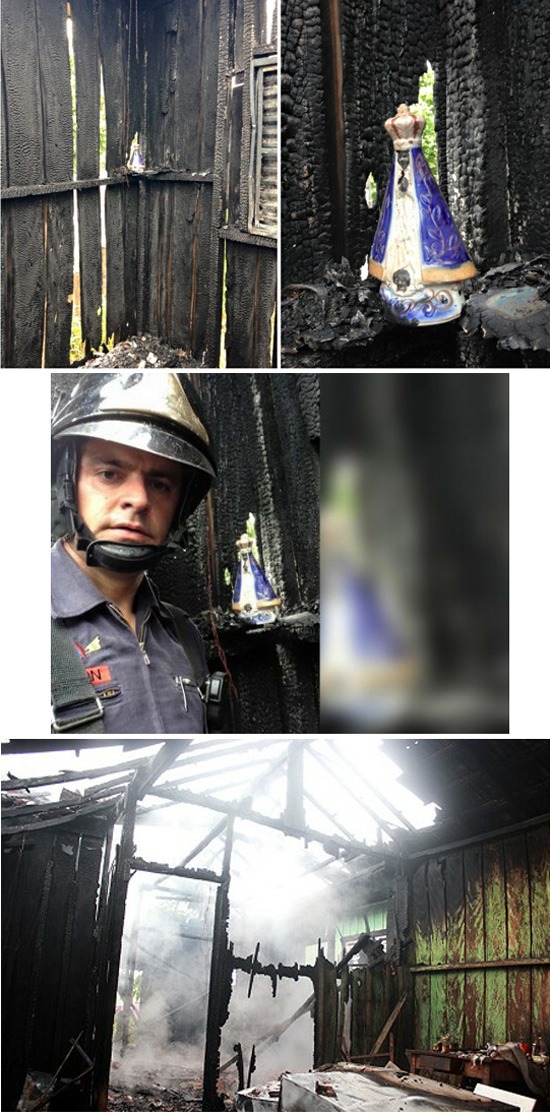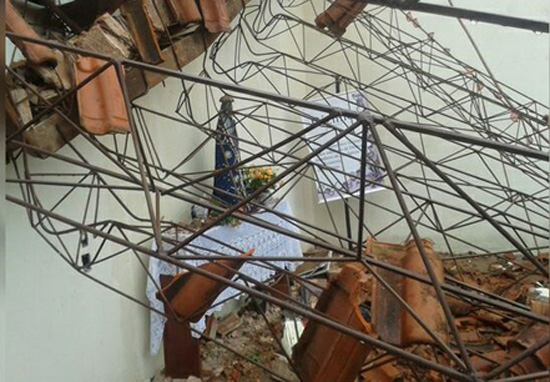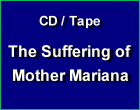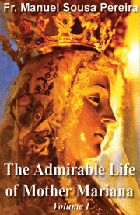What People Are Commenting
Our Lady in the Storms & ‘62 Missal
Two Statues of Our Lady Intact
after Disasters
Dear TIA,
I am from Brazil and I want to tell you about two miracles that occurred on the same day in the countryside of the State of Sao Paulo, both on February 22, 2016.
The first one was with regard to a small statue of Our Lady Aparecida, the Patroness of Brazil, crowned by St. Pius X as the Queen of Brazil. A fire consumed a poor house of wood in the city of Dramacena. When the firemen were leaving, one of them realized that, in one corner of what appeared to have been the living room, a small statue of Our Lady Aparecida was entirely unharmed.
I am sending you some photos: the first is of the house and the statue as it was found. The next shows the fireman who found the statue. The third shows the general damage the fire caused in the house.
On that same day, in the city of Assisi, a chapel collapsed, as you can see in the fourth picture below. Everything was destroyed except for the statue of Our Lady Aparecida.
If these are not lessons for us, I don't know what can be...
In Jesu et Maria,
P.M.


I am from Brazil and I want to tell you about two miracles that occurred on the same day in the countryside of the State of Sao Paulo, both on February 22, 2016.
The first one was with regard to a small statue of Our Lady Aparecida, the Patroness of Brazil, crowned by St. Pius X as the Queen of Brazil. A fire consumed a poor house of wood in the city of Dramacena. When the firemen were leaving, one of them realized that, in one corner of what appeared to have been the living room, a small statue of Our Lady Aparecida was entirely unharmed.
I am sending you some photos: the first is of the house and the statue as it was found. The next shows the fireman who found the statue. The third shows the general damage the fire caused in the house.
On that same day, in the city of Assisi, a chapel collapsed, as you can see in the fourth picture below. Everything was destroyed except for the statue of Our Lady Aparecida.
If these are not lessons for us, I don't know what can be...
In Jesu et Maria,
P.M.


______________________
1962 Missal & Tridentine Mass
Hello,
I just read the article Missal Crisis of ‘62 and am pretty sure that no one yet has referred to the '62 missal as Tridentine, even enthusiasts. Am I correct in this assumption?
A recent article (30th of December 2015) by ChurchMilitant.com discusses the rise of Latin Masses being celebrated across the U.S.A. and later in the article refers to them as Tridentine.
Can you clarify for me, please? Also, is it possible to hear Mass according to pre-'62 ('55) rite?
Thanks and regards,
T.M.
TIA responds:
Hello T.M.,
The Tridentine Mass, strictly speaking (in stricto sensu), is the Mass said according to the Missals that precisely followed the rubrics issued by the Council of Trent and by St. Pius V, who gave those rubrics all their force in the Bull Quo primum tempore.
So, since the 1962 Missal was a transition between the Tridentine Mass and the Novus Ordo Mass that came in the wake of the Vatican II Constitution Sacrosanctum Concilium on the liturgy, it is more appropriate not to refer to the Masses said according to the ‘62 Missal as Tridentine. They were already heading toward the reforms that came later.
However, since essentially the form of the Tridentine Mass was kept in the ‘62 Missal, we can refer to it as Tridentine in the larger sense (in lato sensu). In this regard, it is understandable that many Catholics who attend Masses said according to the ‘62 Missal – for example, those who attend the SSPX chapels – refer to their Masses as Tridentine.
For more information on the differences between the Tridentine Mass and the Masses said according to the ‘62 Missal, please read the answer to the next posting.
In response to your second question: Yes, it is possible to attend the Mass said following the Missals prior to ‘62 in independent chapels of duly ordained priests, as, for example, in Our Lady Help of Christians in Garden Grove, California.
Cordially,
TIA correspondence desk
I just read the article Missal Crisis of ‘62 and am pretty sure that no one yet has referred to the '62 missal as Tridentine, even enthusiasts. Am I correct in this assumption?
A recent article (30th of December 2015) by ChurchMilitant.com discusses the rise of Latin Masses being celebrated across the U.S.A. and later in the article refers to them as Tridentine.
Can you clarify for me, please? Also, is it possible to hear Mass according to pre-'62 ('55) rite?
Thanks and regards,
T.M.
______________________
TIA responds:
Hello T.M.,
The Tridentine Mass, strictly speaking (in stricto sensu), is the Mass said according to the Missals that precisely followed the rubrics issued by the Council of Trent and by St. Pius V, who gave those rubrics all their force in the Bull Quo primum tempore.
So, since the 1962 Missal was a transition between the Tridentine Mass and the Novus Ordo Mass that came in the wake of the Vatican II Constitution Sacrosanctum Concilium on the liturgy, it is more appropriate not to refer to the Masses said according to the ‘62 Missal as Tridentine. They were already heading toward the reforms that came later.
However, since essentially the form of the Tridentine Mass was kept in the ‘62 Missal, we can refer to it as Tridentine in the larger sense (in lato sensu). In this regard, it is understandable that many Catholics who attend Masses said according to the ‘62 Missal – for example, those who attend the SSPX chapels – refer to their Masses as Tridentine.
For more information on the differences between the Tridentine Mass and the Masses said according to the ‘62 Missal, please read the answer to the next posting.
In response to your second question: Yes, it is possible to attend the Mass said following the Missals prior to ‘62 in independent chapels of duly ordained priests, as, for example, in Our Lady Help of Christians in Garden Grove, California.
Cordially,
TIA correspondence desk
______________________
Dear TIA,
I read an article from your site recently titled The Missal Crisis of '62 by Fr. Patrick Perez.
I do not think the article gives a sufficient reason for not being obliged to use the 1962 Missal. Did not John XIII promulgate that Missal with all legal canonical force?
Furthermore, there is nothing evil in that Missal and it cannot be substantiated that it lacks a necessary good to such a degree that it is evil for lacking good. The article cites that St. Joseph was added to Canon as one of its defects. This may have been imprudent because it gets people used to change, but Gregory the Great, I believe, added to the Hanc Igitur of the Canon.
Finally, the article says "if one can justify the use of the 1962 Missal to oneself in spite of all this, then one has no good and valid reason left to proffer for not accepting and using the Missale Romanum of Paul VI, which, it is claimed, likewise contains no specific heresy."
The reason why one can use the 1962 Missal, but not the Novus Ordo Missal is that one is evil because it lacks a necessary good (mentioning the sacrificial nature of the Mass along with other evils) while the other simply changes some feast days around.
It is true that the 1962 Missal was used as a justification for more change, but how can you disobey a universal law of the Church because the previous Missal may have been more preferable and after that a New Missal was illegally "promulgated".
If one can disregard the 1962 Missal, then couldn't a priest disregard the changes of St. Pius X to the Missal and the Liturgy of the Hours because he thought these changes led to more changes and were not as desirable as the previous Missal?
Can't you only disobey a superior if he tells you to do something that is positive evil or evil/sin by omission?
Respectfully yours,
T.R.
TIA responds:
Dear T.R.,
We sent your letter to Msgr. Patrick Perez but, so far, we did not receive an answer. If he answered you directly, please disregard this message. In case he did not, we are giving you a first answer, awaiting his eventual reply.
We believe that the changes of the ‘62 Missal, as well those made in the Holy Week ceremonies in 1955 under Pius XII, were the first waves of a growing tide of reforms. Vatican II and the Novus Ordo represented the high tide of those reforms that had been prepared for decades. You may check how far back this preparation started by reading the series on the Dialogue Mass by Dr. Carol Byrne.
Someone sent us a comparative study made between the ‘62 Missal and the Tridentine Missal. This analysis was made by Bishop Daniel L. Dolan. The paper seemed to us a serious study that focuses on the many changes made, which constituted more than “simply changing some feast days around,” as you affirm. We believe this paper can be useful to many Catholics. May they be aware, however, that the author is sede-vacantist and that we do not agree with this position.
For your convenience, we are placing a copy of this study here.
In your letter, you take a preponderantly juridical approach. However, you forgot to substantiate why you state that the Novus Ordo Mass was illegally promulgated. To promulgate the Novus Ordo, Paul VI had the same power you recognize that John XXIII had to promulgate the ‘62 Missal. What do you think is illegal in Paul VI's promulgation of the 1969 Missal?
Cordially,
TIA correspondence desk.
I read an article from your site recently titled The Missal Crisis of '62 by Fr. Patrick Perez.
I do not think the article gives a sufficient reason for not being obliged to use the 1962 Missal. Did not John XIII promulgate that Missal with all legal canonical force?
Furthermore, there is nothing evil in that Missal and it cannot be substantiated that it lacks a necessary good to such a degree that it is evil for lacking good. The article cites that St. Joseph was added to Canon as one of its defects. This may have been imprudent because it gets people used to change, but Gregory the Great, I believe, added to the Hanc Igitur of the Canon.
Finally, the article says "if one can justify the use of the 1962 Missal to oneself in spite of all this, then one has no good and valid reason left to proffer for not accepting and using the Missale Romanum of Paul VI, which, it is claimed, likewise contains no specific heresy."
The reason why one can use the 1962 Missal, but not the Novus Ordo Missal is that one is evil because it lacks a necessary good (mentioning the sacrificial nature of the Mass along with other evils) while the other simply changes some feast days around.
It is true that the 1962 Missal was used as a justification for more change, but how can you disobey a universal law of the Church because the previous Missal may have been more preferable and after that a New Missal was illegally "promulgated".
If one can disregard the 1962 Missal, then couldn't a priest disregard the changes of St. Pius X to the Missal and the Liturgy of the Hours because he thought these changes led to more changes and were not as desirable as the previous Missal?
Can't you only disobey a superior if he tells you to do something that is positive evil or evil/sin by omission?
Respectfully yours,
T.R.
______________________
TIA responds:
Dear T.R.,
We sent your letter to Msgr. Patrick Perez but, so far, we did not receive an answer. If he answered you directly, please disregard this message. In case he did not, we are giving you a first answer, awaiting his eventual reply.
We believe that the changes of the ‘62 Missal, as well those made in the Holy Week ceremonies in 1955 under Pius XII, were the first waves of a growing tide of reforms. Vatican II and the Novus Ordo represented the high tide of those reforms that had been prepared for decades. You may check how far back this preparation started by reading the series on the Dialogue Mass by Dr. Carol Byrne.
Someone sent us a comparative study made between the ‘62 Missal and the Tridentine Missal. This analysis was made by Bishop Daniel L. Dolan. The paper seemed to us a serious study that focuses on the many changes made, which constituted more than “simply changing some feast days around,” as you affirm. We believe this paper can be useful to many Catholics. May they be aware, however, that the author is sede-vacantist and that we do not agree with this position.
For your convenience, we are placing a copy of this study here.
In your letter, you take a preponderantly juridical approach. However, you forgot to substantiate why you state that the Novus Ordo Mass was illegally promulgated. To promulgate the Novus Ordo, Paul VI had the same power you recognize that John XXIII had to promulgate the ‘62 Missal. What do you think is illegal in Paul VI's promulgation of the 1969 Missal?
Cordially,
TIA correspondence desk.

Posted May 5, 2016


















During the recent 7.8 earthquake in Ecuador on April 16, 2016, which killed hundreds of people, one statue of Our Lady was found intact among the wreckage. I am sending you and your readers a photo that tells everything.
There is a clear message in this miracle: We should resort to Or Lady for our material and spiritual salvation in any circumstance, especially when all human and natural help is impossible.
May the Holy Mother bless your work.
M.C.